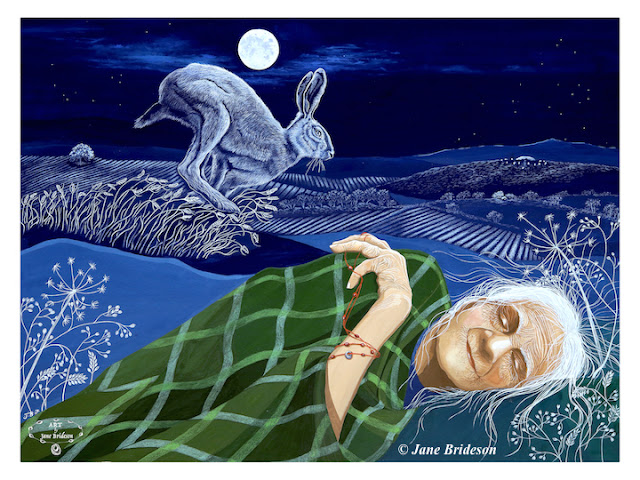A sharp sickle hangs above the Lough Field.
By the hearth I rest my bones, thoughts conjured by shifting shadows.
How much reaping have I seen since those first seeds were planted?
In bygone days they thought my spirit in the corn.
Cutting the Cailleach, Co. Antrim.
Pic © www.duchas.ie
At times my hare-shape, spied amongst the stalks, caused old ones to make the sign and murmur against ill-wishing.
They recognised my power.
Still now, at my great age, I go about at harvest to fulfil my duty.
Barley, wheat, oats and grass, all are judged for fitness.
This year was no exception.
At the swollen moon I lay besides the hearth, shawl wrapped tightly, trusting my gnarled fingers
to remember.
Nine haws, nine knots, a hag stone bound in red.
Eyes closed I breathed archaic words upon the charm.
Damp earth-scent replaced turf smoke.
I diminished,
I re-formed.
Detail from "Into a Hare" by Jane Brideson.
A twitch of whiskers then I was off across the silvered land.
Past Lone Thorn,
Detail from "Into a Hare" by Jane Brideson.
Shining Mound
Detail from "Into a Hare" by Jane Brideson.
and Sacred Well.
Detail from "Into a Hare" by Jane Brideson.
Around the Hag’s Hill then spiralling far beyond.
Fulfilling work began at EQUINOX
"Into a Hare" by Jane Brideson.
The cycle ended I sensed the wholeness in the land.
***
Next morning, an old woman once again, I rose and placed the kettle on the range for tea.
The phone rang.
I knew that smiling voice, “All’s well?”
“ Yes. The harvest’s saved, great goodness in the grain this year.
We’ll celebrate at Samhain so?” I asked.
“Ah, we will of course” came his reply. We laughed and I could see that twinkle in his eye.
The Dagda’s parties were legendary.


























